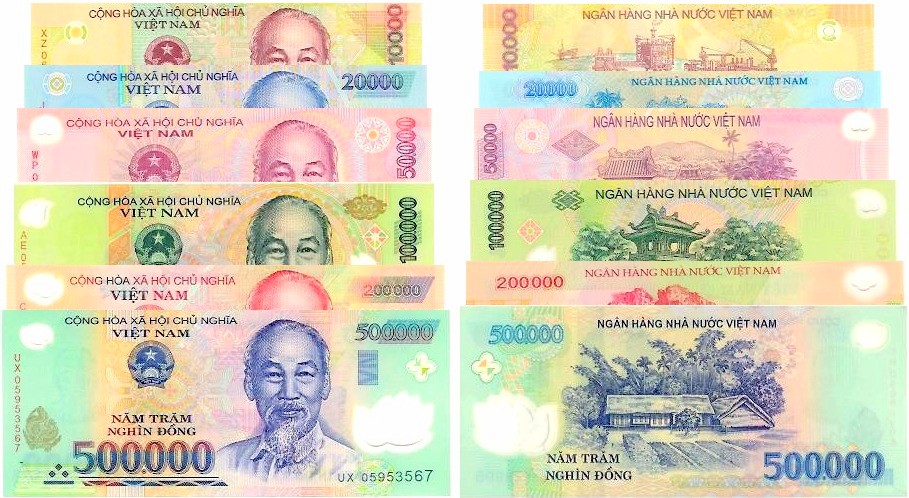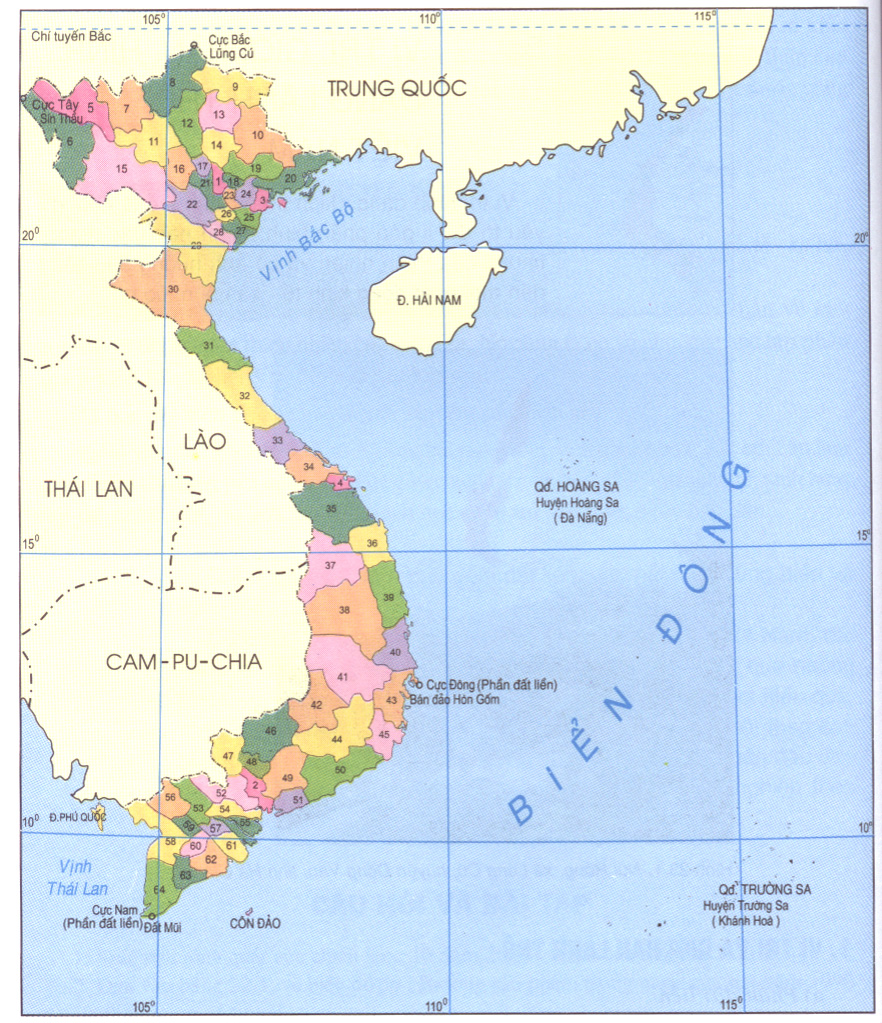Get to know where is Vietnam? What is the best time to travel? Best things to do or what should do while you are in emergency cases? This is a quite long post including almost general aspects of a country. However, this is the best point to start when the idea of taking a tour to Vietnam has just popped in your mind.
GEOGRAPHIC FACTS OF VIETNAM
| Location | Southeastern Asia, bordering the Gulf of Thailand to the South; Gulf of Tonkin, and East Sea to the East; alongside China to the North; Laos, and Cambodia to the West. |
| Area | total: 331,210sq km – land: 310,070sq km |
| Coastline | 3,444 km (excludes islands) |
| The highest point | Fansipan Peak at 3.143m to the sea level |
| The northernmost point | at Lung Cu commune, Dong Van district, Ha Giang province |
| The westernmost point | at Km 0, at Ta Mieu village – Sín thầu commune – Mường Nhé district – Điện Biên Province and 1860m height to the sea level |
| The easternmost point (mainland) | at Đại lãnh pole – Hòa Tâm commune – Tuy Hòa district – Phú Yen province |
| The southernmost point (mainland) | at Mũi village – Đất Mũi commune – Ngọc hiển district – Cà Mau province |
| The biggest cave | Son Doong cave – the biggest of the country and all over the world |
| Main deltas and rivers | Red river in north and Mekong River in south |
| Notable beaches – from North to South | Sam Son in Thanh Hoa (for locals), Cua Lo in Nghe An (for locals), Lang Co in Hue, My Khe in Danang, Cua Dai and An Bang in Hoi an, Nha Trang in Khanh Hoa, Mui Ne in Phan Thiet, and Phu Quoc island. |
Climate and weather:
Because of differences in latitude and the marked variety in topographical relief, the climate tends to vary considerably from place to place. During the winter or dry season, extending roughly from November to April, the monsoon winds usually blow from the northeast along the Chinese coast and across the Gulf of Tonkin, picking up considerable moisture. Consequently, the winter season in most parts of the country is dry only by comparison with the rainy or summer season. The average annual temperature is generally higher in the plains than in the mountains, and higher in the south than in the north.
Temperatures vary less in the southern plains around Ho Chi Minh City and the Mekong Delta, ranging between 21 and 28 °C (69.8 and 82.4 °F) over the course of the year.
Seasonal variations in the mountains and plateaus and in the north are much more dramatic, with temperatures varying from 5 °C (41.0 °F) in December and January to 37 °C (98.6 °F) in July and August. (Read more: best time to travel to Vietnam)
FIGURES ABOUT VIETNAM – THE COUNTRY
| Population | 91,000,000 (July 2012 est.) |
| Capital | Hanoi (Ha Noi) |
| Government | Communist state |
| Flag | red field with a large yellow five-pointed star in the center |
| Electricity Voltage | 127V/ 220V – Frequency: 50HZ |
| Socket | 2 pins |
| Mobile technology | GMS (SIM card based devices) – 3G service available. 4G is in the pilot phase. |
| International Calling Code | +84 – instance for mobile: 0084-902-22-3637 and for desk phone: 0084-43-633-9576 |
| Time Zone | GMT +7 – similar to Bangkok – Thailand, and Jakarta – Indonesia. |
| Measuring system | kilometer, meter, liter, and square meter. |
| Traffic rules | keep to the right hand-side. |
| Currency | Vietnamese Dong(s) – abbreviated to VND or d. Eg. 1,000VND or 1,000d. |
| People | 54 people recognized by the government of which Kinh (or Viet) people are nominated with over 80%. The 20% remain includes H’mong, Thai, Muong, Khmer, Gia Rai etc – all are named “dân tộc thiểu số” (literally “minority people”). |
| Official Languages | Vietnamese (official), English (increasingly favored as a second language), some French, Chinese, Russian, and Khmer. |
| Religion | Buddhist 9.3%, Catholic 6.7%, Hoa Hao 1.5%, Cao Dai 1.1%, Muslim 0.1%, none over 80%. However, the real acting of religions in Vietnam is much different. Most of the Vietnamese are acting Buddhism – Mahayana way with combination to Taoism and ancient worshipping traditions. |
Some highlights to remember:
- The biggest city is Ho Chi Minh city (formerly Sai gon) – located in the South of Vietnam and also the most commercial hub.
- Top mode of transportation: motorbikes and private cars. Public transport services include buses only and available in main cities. Subway and sky train are all at the very first phase of development. (Read more: Vietnam roads and rail)
- Taxi is available at almost of main cities. The price is very much various. 4 Seater car rates are often 5500 – 8000/km, 7 seater car rates are around 8000 – 12000d/km.
- The international airports are Noi Bai (in Hanoi), Tan Son Nhat (in Sai gon) and Danang (in Danang). Danang International airport is just opened for flights mostly from Hongkong and Singapore.
- Notable seaports – from North to South: Cai Lan in Halong, Hai Phong in Hai Phong, Chan May in Hue, Cam Ranh in Nha Trang, Phu My in Vung tau and Sai gon in Ho Chi Minh city. (Read more: Entry Ports to Vietnam)
- The mobile phone providers are Vinaphone, MobileFone, and Viettel. They have pretty similar services quality and price. The SIM card is as cheap as few dollars and easy to buy everywhere.
- 3G service is good enough for web surfing and the coverage is almost the country. The price is quite high if don’t register for a 3G package service.
- Wi-Fi is popular in a household in main cities. Wi-Fi at restaurants, coffee shops, and shopping centers is often free; at hotels, some are free and some are chargeable.
- Airline carriers are Vietnam Airlines – the national flagged carrier, Vietjet Air – the cheap airline and Jetstar – the cheap airline. The cheapest is Vietjet Air. (Read more: Vietnam Airlines and flights)
VIETNAMESE MONEY AND CARD USAGES:

The National currency is Vietnamese Dong. The exchange rates to popular currencies are around 22,400d to 1 USD, 22,800d to 1 EUR, 16,800d to AUD and 29,300d to 1GBP.
Vietnamese bank notes are 500d – 1,000d – 2,000d – 5,000d – 10,000d – 20,000d – 50,000d – 100,000d – 200,000d – 500,000d. The notes of 500d, 1000d, 2000d, 5000d are made from paper; the others are made from polymer marterials. The total of the notes 20,000d and 5,000d, relatively equals to 1 USD. These notes are both in blue color.
Caution: the notes of 20,000d and 500,000d look very much alike: both in polymer materials, blue color, and slightly different in sizes. Please carefully notice when making payments in Vietnamese dongs.
Banks are very accessible in main cities. Some international banks with branches in Vietnam are ANZ bank, HSBC bank, Standard and Chartered, and Citi Banks. Vietnamese banks are Vietcombank – the biggest one, Sacombank, Viettinbank etc.
ATMs in Vietnam are installed nationwide. The AMTs allow withdrawing Vietnamese Dongs only. Most of credit/debit cards are usable at AMTs.
The cards are accepted in almost transactions within main cities. There are several online card payment gateways, too, eg: Onepay, Vnpay etc. Paypal in Vietnam is not as popular as in Western countries. The processing charges are often 1.3 – 3.8% depending on merchant policies.
VIETNAM MEDICAL EMERGENCY:
The medical and emergency treatment has been rather good. There are several national hospitals being able to deal with urgent and complicated treatment and surgeries however the language barrier can be a problem. For mild, common illness and injuries, international hospital or private clinics are much more effective. They can issue medical reports in English for your insurance claim, too. The national emergency number is 115 – Vietnamese speaking only.
CRIME AND POLICE HELP:
Severe crime in Vietnam, especial targeting to tourists, is not typical. The most common issues are pocket lifting and taxi scam. The reason is mostly from taking advantages of the situation when you don’t pay enough attention to personal items. Kidnapping, hi-jack, sexual harassment or brutal attack etc. Are hardly seen or recorded. Prostitution is forbidden by law and sex tourism is illegal in Vietnam. The national police number is 113 – Vietnamese speaking only.
WHAT TO EXPECT WHEN VISITING VIETNAM:
Vietnam is a country opening for decades and very familiar with the travel industry. You can arrange the most luxurious services to the hardest adventure tours in Vietnam. The diversity of the country from North to South with various, beautiful nature can convince any traveler.
You may be stunning with magnificent terrace fields in Sapa, then immerse yourself in a beautiful trip on a cruise in Halong bay. Vietnam is also famous for her beaches that stretch from north to south and the world class beaches are in from Central to South. Vietnam beaches can compete to any other beaches over the world. Some famed names listed in a well-known magazine are My Khe beach, Nha Trang beach, and Phu Quoc beach.
Vietnam culture is unique in comparison to other countries in Indochina. For instance, while most of Indochina countries is practicing Theravada, Vietnam Buddhism is Mahayana. However, this is not the sole Mahayana but blended with ancient worshipping tradition (find out more here). Vietnamese food and cuisine are not spicy as in Thailand or not oily as in China. Our gastronomy is healthy, fresh and tasty with plenty of spicy and vegetable.
You may expect all things of your dream holiday when you decide to travel to Vietnam. Vietnamese people are generally warm, kind-hearted and welcoming you to their homes. Despite the language issue, you can feel their kindness and hospitality with the patience of body language or learn some Vietnamese phrase in advance.


